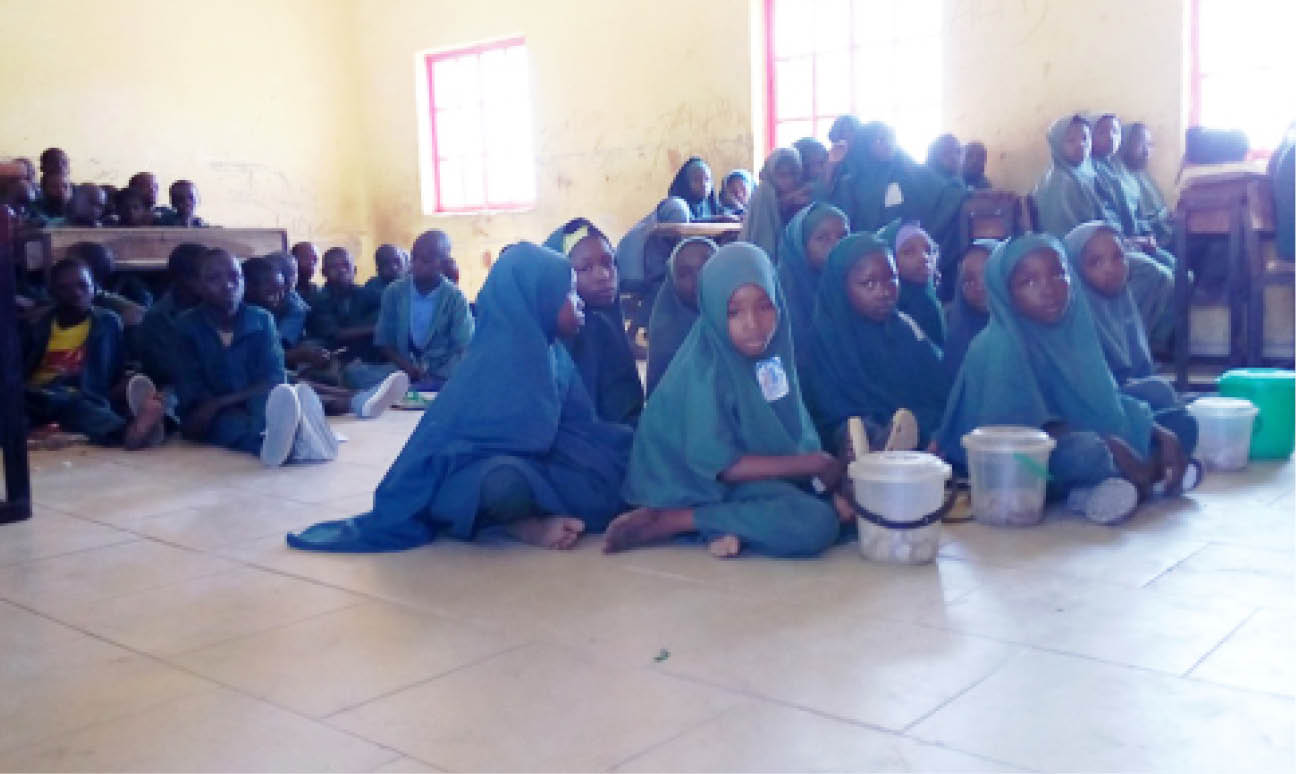No seats in the house
It is health education hour at a primary school in Keffi, Nasarawa. The teacher shouts to get the attention of pupils. Nearly 100 of them are packed in the class. “We should clean our mouths daily with toothbrush and toothpaste,” he chants. The children repeat the chant after him. They are all seated on the […]

Pupils at a special primary school in Janguza, Kano PHOTOS: Judd-Leonard Okafor
It is health education hour at a primary school in Keffi, Nasarawa. The teacher shouts to get the attention of pupils. Nearly 100 of them are packed in the class.
“We should clean our mouths daily with toothbrush and toothpaste,” he chants. The children repeat the chant after him.
They are all seated on the floor. The classroom has no desks or chairs, and that is almost normal for the entire school.
“I am not happy,” says a schoolteacher who’s opted not to be named. “By the time I joined here, I met all the children sitting on the floor up till now. How can a child come to school to sit on the floor?

The number 10 million is historic in Nigeria. That’s the number of school-age children who are not in school. It has climbed to almost 13 million.
Intense efforts are on to get more school-age children off the streets and into classrooms.
A programme to provide at least one meal in school is helping bring more children into school.
The numbers are encouraging, analysts agree, but the condition of schooling is raising further concerns.
“During our time, we didn’t sit on the floor. Maybe the government knows why, maybe because their children are not in public schools. We don’t know,” says the schoolteacher.
The school teachers say they have been writing officials about pupils taking classes on the floor, but nothing has come of it.
In another class, a portion of the roof has fallen out. A wooden strut rise from the floor to support what’s left of the roof. No chairs in the class.
To make chairs, school desks are stuck end to end in two rows. In each row, 15 pupils perch on the desks for seats. Their books in their hands, they have no desks to write on.
The rest of the children squat cross-legged on the floor. Through their half shirt sleeves and shorts, their bare arms and knees are smudged with dust. Lessons go all day that way.
Last year, a nongovernment organization donated chairs and desks to fill the gap.
Teachers themselves find the lack “embarrassing.”
“When I was in primary school, the population wasn’t like this, and we never sat on the floor,” says another school teacher.
In Janguza, Kano, a new maximum-security prison is under construction. Within sight of it sits the Army Childrens’ Special Primary School. It is a sprawling collection of classroom blocks. Its paintwork looks new.
One block is for pre-primary class of 40 children aged up to five years. Eight coloured plastic chairs are set around each square table.
The class is packed with toys and learning aids. To create a homelike environment, children can move between their seats and the cemented floor.
In the primary section, seats are not an option for many students-up to primary six. Only five desks are available for a full class of more than 60 students.
Four students squeeze onto each available seat; the rest squat on the floor in their green uniform. The physical and health education lesson goes on.
Of the nearly 13 million children out of school, four million of them are in Kano-the largest for any single state.
Teachers and education advocates worry about the quality of learning for children in environment considered not to be conducive. One teacher teaches his health education class in Hausa. Teachers who don’t speak the language are learning to inject Hausa words into lessons to aid understanding.
Gabriel Ushahema was posted to the school under the N-Power scheme, a programme to create jobs for unemployed young people. He is surprised many of his primary-six pupils who trek long distances to get to class don’t speak a word of English.
“I met them the way they are,” he says. “Imagine how a child in primary six can’t speak English. But when I look around, I discover from the environment and even some staff do teach in Hausa. That contributes.”
But that doesn’t stop his class. “I have to speak english little words in Hausa. Sometimes in the course of teaching, I mention them. And sometimes we use screens. When they see with their eyes, they understand. Sometimes we have to do practicals,” he says.
The race to get children into school is swelling class sizes beyond what infrastructure and furniture can handle. Each child in school is a tick in the positive column of school enrolment balance sheet-even if that means classrooms double as trading posts.
Among the girls squatted on the floor of the classroom, some mix classes with trading. On their trek to school, they come with transparent plastic jars filled with packs of fried groundnut. The jars sit next to their notebooks on the floor. The trade goes into full swing during recess.
Teachers are aware of the trade, but they can’t stop it.
“Most of the parents rely on what children sell to support themselves,” says Hassan Yaru, a deputy director for social mobilisation with the state’s Universal Basic Education Board.
“Actually it is not a bad. The end situation is not having these children in school. You cannot stop them from the beginning from selling. Their continuation to stay in school is what matters.”
They will stay on, but their learning conditions get worse.
